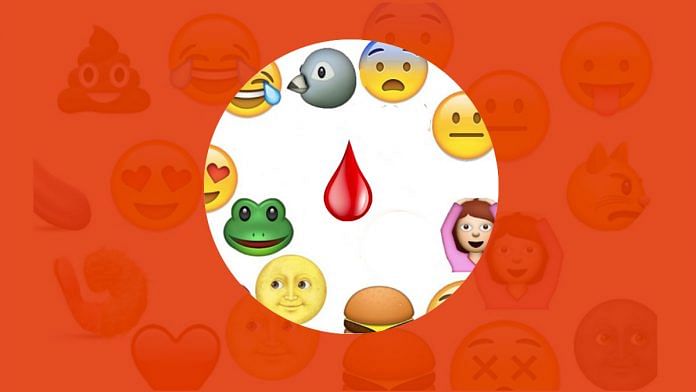New Delhi: For all the Indians who grew up believing that menstrual blood was blue in colour, Apple Inc. has an innovative solution — a period emoji.
Earlier this week, the multi-billion dollar tech behemoth added nearly 400 new emojis as a part of its latest iOS update, including people in wheelchairs, with prosthetic arms and legs, up to 75 possible combinations in skin colour and gender in the holding-hands emoji, gender-neutral people, and a drop of blood to represent menstruation.
It’s time to celebrate?the blood drop emoji's arrival!
A #PeriodEmoji makes it easier for women & girls to talk about their periods & helps break down #PeriodStigma ?
To access yours, download the IOS update today?
More about our work here➡️https://t.co/tmTptkATl1 pic.twitter.com/zSNU02kO4d
— Plan International UK (@PlanUK) October 29, 2019
“It reminds me of the ‘right to bleed campaign’ a couple of years ago, saying that we wouldn’t carry our menstrual pads in a black bag, so it’s interesting to see the way in which technology is also visibilising and normalising taboos,” says Kalpana Basu, co-founder of SafetiPin, an app using big data to make cities safer for women.
“When we were younger feminists, we didn’t really take up these causes, also because the platforms didn’t exist,” Basu says, adding that “menstruation is a big issue in India, linked to the Hindu concept of shame, purity and pollution. So in India it will be quite radical to put a drop of blood to say you’re having your period, and it’s conversations like these that will eventually lead to greater sensitivity on a whole range of issues.”
The very first emoji — the classic yellow smiling face — appeared in 1999, and by 2017, ‘emoji’ was Oxford Dictionary’s word of the year. As modes of communication get increasingly digitised, shorter attention spans and faster living have led to an overwhelming reliance on visual mediums of interaction.
The rise of the video format, coinciding with people reading less and Tweeting more, has resulted in the “emoji emerging as its own tenet of communication. It’s not as innocuous and ‘un-serious’ as we once thought,” Smita Vanniyar tells ThePrint. Working as the second lead of digital projects at Point of View, an organisation aimed at amplifying women’s voices in digital and real-world spaces, Vanniyar believes that while Apple’s move is favourable, “it’s definitely not enough”.
“Of course it’s for woke points,” Vanniyar says. “But that doesn’t mean its impact isn’t important. However still, you can’t bask in the glow of emojis alone and pretend you’re very woke, because there’s exploitation of labour and a lot of issues with Apple, which at the end of the day is a capitalistic multi-billion dollar data collector.”
Also read: Ten years of WhatsApp: From chat revolution to political weapon to Whexit
Class barriers and the logic of percolation
In September, Apple unveiled the iPhone 11, iPhone 11 Pro and iPhone 11 Pro Max. While iPhone 11 is priced at Rs 65,000, the other two models cost nearly Rs 1 lakh. Being one of the costliest pieces of technology in its segment, Apple has long remained a status symbol — and given the income demographics of India, is largely out of reach for a majority of the population.
“The Apple phone itself it too expensive for a lot of people to use in India,” Basu admits. “But if Apple does it today, Android might do it tomorrow, and then it’ll peter down to cheaper phones also.”
“It’s easier to put pressure on other operating systems this way… And social change, which is a slow-moving process, has to start somewhere,” Vanniyar adds.
Also read: WhatsApp surveillance: Are Supreme Court guidelines on tapping outdated & need strengthening?
The need for representation
In India, where the colonial-era law criminalising homosexuality was scrapped just over a year ago, and where insufficient awareness about reproduction and superstitions linked to notions of purity have relegated the menstrual cycle to a taboo subject, Apple’s new initiative is particularly significant.
Identifying as non-binary, Vanniyar also recalls the personal experience of having to “put both the male and female facepalm emoji because I didn’t associate singularly with anyone”.
“It might be a really small change, but then that depends on what position of privilege you’re speaking from — if you’re straight, cisgender, English speaking, and have conventional masculine or feminine markers, then you might not think this is a big deal, but for so many other people, who have had to wait years for recognition in the mainstream, it does have some impact,” Vanniyar says.
With over 400 million Indians on WhatsApp and 120 million on Instagram, representation on social media is a numbers game and the emoji has taken on cultural interpretations of its own.
In China for example, where state censorship and surveillance is high, social media users re-named the #MeToo campaign as the #RiceBunny movement (accompanied by emojis of rice bowls and bunny heads) because the words “Rice Bunny’ in conjunction are pronounced as “mi tu”. From secret languages used by gangs to the personal symbolism of a purple versus red heart, the emoji carries a parallel linguistic significance of its own.
“From childbirth and breastfeeding — I think emojis like this could be a start in informing us that the female body is not just sexual, but a functional body. Apple’s emojis carry an important message, that gender isn’t binary, identity is fluid, and your individual experience is represented and seen, if even within a particular class,” Basu says.



